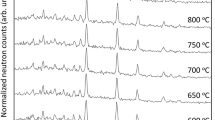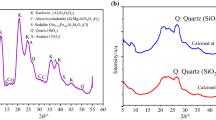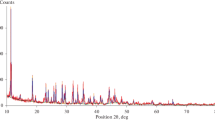Abstract
Rhyolite is an extrusive, igneous rock of aluminosilicate composition that upon rapid cooling forms obsidian. Obsidian is amorphous and contains limited water portions (< 2 mass%); however, secondary hydration turns it either to perlite (H2O ≈ 2–5 mass%) or pitchstone (> 5 mass%). In the current study, kinetics of hydrous rhyolite dehydration were investigated by thermogravimetry up to 1000 °C, at heating rates of 2.5, 5, 10 and 20 °C min−1 and under inert atmosphere. The mass loss is approx. 7.6 mass%, occurs along wide temperature range (100–800 °C) and is solely attributed to the release of molecular water ((H2O)m) and hydroxyl groups (OH). Rhyolite dehydration was considered as a solid-state reaction, and the apparent activation energy (Ea) of dehydration was calculated throughout the whole conversion range (a) by applying the isoconversional Friedman and advanced Vyazovkin methods. Both methods revealed inverse sigmoid trend in Ea values versus conversion degree, possessing almost stable value of 61 ± 5 kJ mol−1 for Friedman method and 59.44 kJ mol−1 for Vyazovkin method on conversion range between 0.25 and 0.75, and sharp increase at higher conversion degree. The intensive change in Ea during dehydration progression is attributed to the change in releasing species (from (H2O)m to OH). Raman and FT-IR spectroscopy analyses of raw and partially dehydrated samples at different stages revealed that up to 300 °C mainly (H2O)m is diffused out of the material causing sample enrichment in OH groups. OH release, which occurs at relatively higher temperature, is accompanied by increase in apparent Ea value of dehydration. Concerning microstructure of raw rhyolite, it exhibits a network of micro-fractures which serve as water release routes. Upon heating, more and wider fractures are created. At 600 °C, fractures merging occurs creating voids, which constitute forerunners of the expansion phenomenon. Further temperature increase causes material softening allowing local plastic deformation, which under the high pressure that is exerted by the releasing water species incites the formation of large cavities and fractures, initiating expansion.












Similar content being viewed by others
References
Le Maitre R, Streckeisen A, Zanettin B, Le Bas M, Bonin B, Bateman P. Igneous rocks: a classification and glossary of terms: recommendations of the international union of geological sciences subcommission on the systematics of igneous rocks. 2nd ed. Cambridge: Cambridge University Press; 2002.
Denton JS, Tuffen H, Gilbert JS, Odling N. The hydration and alteration of perlite and rhyolite. J Geol Soc London. 2009;166(5):895–904.
Sodeyama K, Sakka Y, Kamino Y, Seki H. Preparation of fine expanded perlite. J Mater Sci. 1999;34(10):2461–8.
Liritzis I. Encyclopedia of scientific dating methods. Encycl Sci Dating Methods. 2013;609–24.
Dalakishvili AI. Glass formation in perlite—and obsidian-containing batches. Glas Phys Chem. 2005;31(6):820–2.
Roulia M, Chassapis K, Kapoutsis JA, Kamitsos EI, Savvidis T. Influence of thermal treatment on the water release and the glassy structure of perlite. J Mater Sci. 2006;41(18):5870–81.
Ihinger PD, Zhang Y, Stolper EM. The speciation of dissolved water in rhyolitic melt. Geochim Cosmochim Acta. 1999;63(21):3567–78.
Roulia M, Chassapis K, Fotinopoulos C, Savvidis T, Katakis D. Dispersion and sorption of oil spills by emulsifier-modified expanded perlite. Spill Sci Technol Bull. 2003;8(5–6):425–31.
Jambon A, Zhang Y, Stolper EM. Experimental dehydration of natural obsidian and estimation of DH2O at low water contents. Geochim Cosmochim Acta. 1992;56(7):2931–5.
Silver LA, Ihinger PD, Stolper E. The influence of bulk composition on the speciation of water in silicate glasses. Contrib Miner Petrol. 1990;104(2):142–62.
Zhang Y, Stolper EM, Wasserburg GJ. Diffusion of water in rhyolitic glasses. Geochim Cosmochim Acta. 1991;55(2):441–56.
Bagdassarov N, Ritter F, Yanev Y. Kinetics of perlite degassing: TG and DSC analysis. Glas Sci Technol. 1999;72(9):277–90.
Freeman ES, Carroll B. The application of thermoanalytical techniques to reaction kinetics. The thermogravimetric evaluation of the kinetics of the decomposition of calcium oxalate monohydrate. J Phys Chem. 1958;62(4):394–7.
Okumura S, Nakashima S. Water diffusivity in rhyolitic glasses as determined by in situ IR spectroscopy. Phys Chem Miner. 2004;31(3):183–9.
Chatterjee KK. Uses of industrial minerals, rocks and freshwater. In: Nova Science, New York, vol 53, Nova Science Publishers; 2013. pp 1689–1699.
Angelopoulos PM, Gerogiorgis DI, Paspaliaris I. Model-based sensitivity analysis and experimental investigation of perlite grain expansion in a vertical electrical furnace. Ind Eng Chem Res. 2013;52(50):17953–75.
Friedman I, Long W, Smith RL. Viscosity and water content of rhyolite glass. J Geophys Res. 2012;68(24):6523–35.
Angelopoulos PM, Maliachova C, Papakonstantinou K, Taxiarchou M, Diplas S. Structural and physical characteristics of fine perlite expanded with a novel method in a vertical electric furnace. Miner Process Extr Metall. 2016;125(2):71–80.
Angelopoulos PM, Samouhos M, Taxiarchou M, Tsakiridis P, Haggman J, Joyce P. A new thermal treatment process of low value volcanic glass towards the production of expanded material and its use on CNTs’ synthesis as substrate material. IOP Conf Ser Mater Sci Eng. 2018; 362(1)
U.S. Geological Survey. Mineral commodity summaries 2019. Reston: U.S. Geological Survey; 2019.
Perlite Institute INC. Test methods and related standards. New York; 1984. P 50.
Ross CS, Smith RL. Water and other volatiles in volcanic glasses*. Am Miner. 1955;40(11–12):1071–89.
Angelopoulos PM, Gerogiorgis DI, Paspaliaris I. Mathematical modeling and process simulation of perlite grain expansion in a vertical electrical furnace. Appl Math Model. 2014;38(5–6):1799–822.
Brown ME, Maciejewski M, Vyazovkin S, Nomen R, Sempere J, Burnham A, et al. Computational aspects of kinetic analysis Part A: the ICTAC Kinetics Project-data, methods and results. Thermochim Acta. 2000;355(1–2):125–43.
Vyazovkin S, Burnham AK, Criado JM, Pérez-Maqueda LA, Popescu C, Sbirrazzuoli N. ICTAC Kinetics Committee recommendations for performing kinetic computations on thermal analysis data. Thermochim Acta. 2011;520(1–2):1–19.
Friedman HL. Kinetics of thermal degradation of char-forming plastics from thermogravimetry. Application to a phenolic plastic. J Polym Sci Part C Polym Symp. 1963;6(1):183–95.
Xie Q, Xie Y, Liu W, Zhang L, Li S, Chen H. Thermal decomposition behaviour and kinetics of a mixed solution: n-propyl nitrate and nitric acid solution. J Therm Anal Calorim. 2020;140(4):1801–10.
Vyazovkin S. Evaluation of activation energy of thermally stimulated solid-state reactions under arbitrary variation of temperature. J Comput Chem. 1997;18(3):393–402.
Vyazovkin S, Dollimore D. Linear and nonlinear procedures in isoconversional computations of the activation energy of nonisothermal reactions in solids. J Chem Inf Comput Sci. 1996;36(1):42–5.
Huang Z, Jie Wang X, Lu T, Dan Nong D, Yang Gao X, Xu Zhao J, et al. Isoconversional kinetic analysis of thermal decomposition of 1-butyl-3-methylimidazolium hexafluorophosphate under inert nitrogen and oxidative air atmospheres. J Therm Anal Calorim. 2020;140(2):695–712.
Torres-Garcia E, Brachi P. Non-isothermal pyrolysis of grape marc: thermal behavior, kinetics and evolved gas analysis. J Therm Anal Calorim. 2020;139(2):1463–78.
Senum GI, Yang RT. Rational approximations of the integral of the Arrhenius function. J Therm Anal. 1977;11(3):445–7.
Kaufhold S, Reese A, Schwiebacher W, Dohrmann R, Grathoff GH, Warr LN, et al. Porosity and distribution of water in perlite from the island of Milos, Greece. J Korean Phys Soc. 2014;3(1):1–10.
Thomas PS, Heide K, Földvari M. Water and hydrogen release from perlites and opal: a study with a directly coupled evolved gas analyzing system (DEGAS). J Therm Anal Calorim. 2015;120(1):95–101.
Lehman H, Roosler M. A contribution to the nature of water bindingin Perlite, Thermal Analysis, vol. 2. In: Proceedings of the 4th ICTA conference, Budapest, pp. 619–628.
Cai J, Chen Y. Iterative linear integral isoconversional method: theory and application. Bioresour Technol. 2012;103(1):309–12.
Khawam A, Flanagan DR. Role of isoconversional methods in varying activation energies of solid-state kinetics: II. Nonisothermal kinetic studies. Thermochim Acta. 2005;436(1–2):101–12.
Stolper E. Water in silicate glasses: an infrared spectroscopic study. Contrib Miner Pet. 1982;81:1–17.
Zujovic Z, Wheelwright WVK, Kilmartin PA, Hanna JV, Cooney RP. Structural investigations of perlite and expanded perlite using 1H, 27Al and 29Si solid-state NMR. Ceram Int. 2018;44(3):2952–8.
Chabiron A, Pironon J, Massare D. Characterization of water in synthetic rhyolitic glasses and natural melt inclusions by Raman spectroscopy. Contrib Miner Petrol. 2004;146(4):485–92.
Zajacz Z, Halter W, Malfait WJ, Bachmann O, Bodnar RJ, Hirschmann MM, et al. A composition-independent quantitative determination of the water content in silicate glasses and silicate melt inclusions by confocal Raman spectroscopy. Contrib Miner Petrol. 2005;150(6):631–42.
Yoshino H, Kamiya K, Nasu H. IR study on the structural evolution of sol-gel derived SiO2 gels in the early stage of conversion to glasses. J Non Cryst Solids. 1990;126(1–2):68–78.
Bertoluzza A, Fagnano C, Antonietta Morelli M, Gottardi V, Guglielmi M. Raman and infrared spectra on silica gel evolving toward glass. J Non Cryst Solids. 1982;48(1):117–28.
Ingram M, Davidson J, Coats A, Kamitsos E, Kapoutsis J. Origins of anomalous mixed-cation effects in ion-exchanged glasses. Glas Sci Technol. 2000;73:89–104.
Kamitsos E, Patsis A, Kordas G. Infrared-reflectance spectra of heat-treated, sol-gel-derived silica. Phys Rev B. 1993;48(17):12499–505.
Brawer SA, White WB. Raman spectroscopic investigation of the structure of silicate glasses I The binary alkali silicates. J Chem Phys. 1975;63(6):2421–32.
Mysen BO, Virgo D, Seifert FA. The structure of silicate melts: implications for chemical and physical properties of natural magma. Rev Geophys. 1982;20:353–83.
Matson D, Sharma S, Philpotts J. The structure of high-silica alkali-silicate glass. A Raman spectroscopic investigation. J Non Cryst Solids. 1983;58:323–52.
McMillan P. Structural studies of silicate glasses and melts—applications and limitations of Raman spectroscopy. Am Miner. 1984;69(6–8):622–44.
Marshall R. Devitrification of Natural Glass. GSA Bull. 1961;72(10):1493–520.
Friedman I, Smith RL, Long WD. Hydration of natural glass and formation of perlite. GSA Bull. 1966;77(3):323–8.
Fowler A. Mathematical Geoscience. London: Springer; 2011. pp. 41–52.
Author information
Authors and Affiliations
Corresponding author
Additional information
Publisher's Note
Springer Nature remains neutral with regard to jurisdictional claims in published maps and institutional affiliations.
Rights and permissions
About this article
Cite this article
Angelopoulos, P.M., Manić, N., Tsakiridis, P. et al. Dehydration of rhyolite: activation energy, water speciation and morphological investigation. J Therm Anal Calorim 142, 395–407 (2020). https://doi.org/10.1007/s10973-020-10105-2
Received:
Accepted:
Published:
Issue Date:
DOI: https://doi.org/10.1007/s10973-020-10105-2




